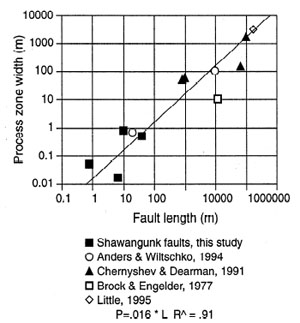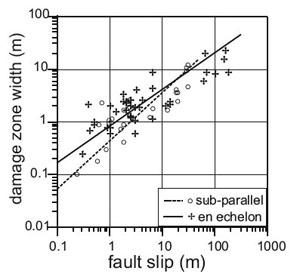| |||||||
|
|
|||||||
|
|
|||||||
| Scaling between Fault Length and Fault Damage Zone Width | |||||||
|
As slip on a fault progressively accumulates and the fault grows in lateral extent, the thickness of the fault damage zone also expands. Very roughly, Vermilye and Scholz (1998) showed that the width of damage zones is a little larger than a hundredth of the fault length (Figure 1).
In a similar fashion, Myers and Thompson (1998) showed scaling statistics from sheared joint-based faults in sandstone between the damage zone width and fault slip (Figure 2). Myers and Thompson were further able to show that different scaling statistics resulted from different geometric configurations of pre-existing weaknesses from which the faults evolved. The width of the damage zone can also be estimated from the length of the maximum splays and the kink angles. Refer to the sections in Related Concepts for detail. It should be kept in mind that fault damage zone width varies significantly as noted under 'Thickness Distribution of Damage Zone.' The details of this variation can be found in de Joussineau and Aydin (2007) for a well-studied case. | |||||||
| Reference: |
|||||||
| de Joussineau, G., Aydin, A., 2007 Gillespie, P.A., Walsh, J.J., Watterson, J., 1992 Myers, R., Thompson, L.B., 1998 Vermilye, J., Scholz, C.H., 1998 |
|||||||
|
Readme | About Us | Acknowledgement | How to Cite | Terms of Use | Ⓒ Rock Fracture Knowledgebase |
|||||||

